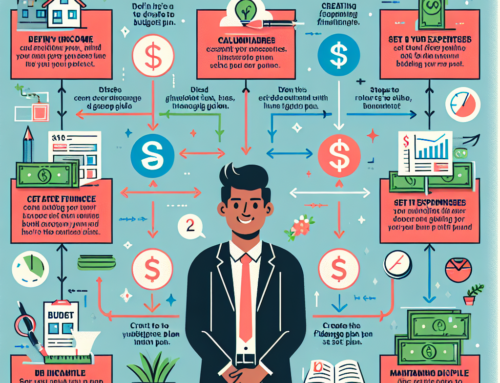
Creating a Budget: The First Step Towards Financial Independence
Achieving financial independence is a goal that many people strive for. It means having enough money to cover your expenses and live the life you want without relying on a job or anyone else for financial support. While it may seem like a daunting task, it is possible to achieve financial independence with the right mindset and strategies. The first step towards this goal is creating a budget.
A budget is a plan that outlines your income and expenses. It helps you track where your money is going and allows you to make informed decisions about your spending. Creating a budget is essential because it gives you a clear picture of your financial situation and helps you identify areas where you can cut back on expenses.
The first thing you need to do when creating a budget is to gather all your financial information. This includes your income, expenses, and any debts you may have. It’s important to be honest and thorough when gathering this information. You can use bank statements, pay stubs, and credit card statements to get an accurate picture of your finances.
Once you have all your financial information, it’s time to categorize your expenses. Start by listing your fixed expenses, such as rent or mortgage, utilities, and insurance. These are expenses that stay the same every month and are necessary for your basic needs. Next, list your variable expenses, such as groceries, entertainment, and clothing. These are expenses that can fluctuate from month to month and are not essential.
After listing your expenses, it’s time to compare them to your income. Your income should be higher than your expenses. If it’s not, you will need to make some adjustments to your budget. This could mean finding ways to increase your income or cutting back on expenses.
One way to cut back on expenses is by identifying areas where you can make changes. For example, you could reduce your grocery bill by meal planning and buying in bulk. You could also save money on entertainment by finding free or low-cost activities. It’s important to be realistic when making these changes. Cutting back too much can lead to frustration and make it difficult to stick to your budget.
Another important aspect of creating a budget is setting financial goals. These goals can be short-term, such as paying off a credit card, or long-term, such as saving for retirement. Having clear financial goals can help you stay motivated and focused on your budget. It’s also important to regularly review and adjust your budget as needed. Life circumstances and expenses can change, so it’s essential to be flexible with your budget.
Creating a budget is not a one-time task. It’s an ongoing process that requires discipline and commitment. It’s important to track your expenses and income regularly to ensure that you are staying on track with your budget. There are many budgeting tools and apps available that can make this process easier.
In conclusion, creating a budget is the first step towards achieving financial independence. It allows you to have a clear understanding of your finances and make informed decisions about your spending. Remember to be honest and thorough when gathering your financial information, categorize your expenses, and set realistic goals. Regularly reviewing and adjusting your budget will help you stay on track towards achieving financial independence. With dedication and perseverance, you can take control of your finances and work towards a future of financial freedom.
Investing for the Future: Strategies for Building Wealth
Achieving financial independence is a goal that many people strive for. It means having enough money to support yourself and your lifestyle without relying on a job or anyone else. It may seem like a daunting task, but with the right strategies and mindset, it is achievable for anyone. In this article, we will discuss a step-by-step guide on how to achieve financial independence through investing for the future.
Step 1: Set Financial Goals
The first step towards achieving financial independence is to set clear and achievable financial goals. These goals will serve as your roadmap and motivate you to stay on track. Start by determining your current financial situation, including your income, expenses, and debts. Then, think about where you want to be in the future. Do you want to retire early? Buy a house? Travel the world? Once you have a clear idea of your goals, you can start planning how to achieve them.
Step 2: Create a Budget
Creating a budget is crucial for managing your finances and achieving your goals. It involves tracking your income and expenses and making adjustments to ensure that you are living within your means. Start by listing all your sources of income and then your monthly expenses, including rent, utilities, groceries, and any debt payments. This will give you a clear picture of where your money is going and where you can make cuts to save more.
Step 3: Pay Off Debt
Debt can be a significant obstacle to achieving financial independence. High-interest debt, such as credit card debt, can eat away at your income and make it challenging to save for the future. Make a plan to pay off your debts, starting with the ones with the highest interest rates. Consider consolidating your debts or negotiating with creditors for lower interest rates. Once you are debt-free, you can redirect that money towards your savings and investments.
Step 4: Build an Emergency Fund
An emergency fund is essential for financial stability. It is a savings account that you can dip into in case of unexpected expenses, such as a medical emergency or job loss. Aim to save at least three to six months’ worth of expenses in your emergency fund. This will give you peace of mind and prevent you from going into debt in case of an emergency.
Step 5: Start Investing
Investing is a crucial step towards achieving financial independence. It involves putting your money into assets that have the potential to grow over time. The earlier you start investing, the more time your money has to grow. Consider investing in a diverse portfolio of stocks, bonds, and real estate. You can also seek the help of a financial advisor to create an investment plan that aligns with your goals and risk tolerance.
Step 6: Maximize Retirement Savings
Retirement may seem far away, but it is essential to start saving for it early. Take advantage of your employer’s retirement plan, such as a 401(k) or IRA, and contribute as much as you can. These plans offer tax benefits and compound interest, which can significantly increase your savings over time. If your employer offers a matching contribution, make sure to contribute enough to receive the full match.
Step 7: Continuously Educate Yourself
The world of finance and investing is constantly evolving, and it is crucial to stay informed. Continuously educate yourself on personal finance, investing, and other related topics. Attend seminars, read books, and follow reputable financial experts to stay up-to-date with the latest trends and strategies. This will help you make informed decisions and adjust your plan accordingly.
In conclusion, achieving financial independence requires discipline, patience, and a solid plan. By setting clear goals, creating a budget, paying off debt, building an emergency fund, investing, maximizing retirement savings, and continuously educating yourself, you can take control of your finances and work towards a financially independent future. Remember, it is never too late to start, so start taking steps towards your financial independence today.
Debt Management: How to Pay Off Debt and Stay Financially Independent
Financial independence is a goal that many people strive for. It means having enough money to cover your expenses and live the life you want without relying on a paycheck. However, achieving financial independence requires careful planning and discipline, especially when it comes to managing debt. In this article, we will provide a step-by-step guide on how to pay off debt and stay financially independent.
Step 1: Assess Your Debt
The first step towards paying off debt is to assess your current financial situation. Make a list of all your debts, including credit card balances, loans, and mortgages. Write down the interest rates and minimum monthly payments for each debt. This will give you a clear picture of how much you owe and how much you need to pay each month.
Step 2: Create a Budget
Once you have a clear understanding of your debt, it’s time to create a budget. A budget will help you track your expenses and identify areas where you can cut back to free up more money for debt repayment. Start by listing all your monthly income, including your salary, bonuses, and any other sources of income. Then, list all your expenses, including rent, utilities, groceries, and entertainment. Be honest with yourself and include all your expenses, no matter how small. This will give you a realistic view of your spending habits.
Step 3: Prioritize Your Debts
Now that you have a budget in place, it’s time to prioritize your debts. There are two popular methods for prioritizing debt repayment: the snowball method and the avalanche method. The snowball method involves paying off the smallest debt first while making minimum payments on all other debts. Once the smallest debt is paid off, you move on to the next smallest debt, and so on. The avalanche method, on the other hand, involves paying off the debt with the highest interest rate first while making minimum payments on all other debts. This method can save you more money in the long run, but it may take longer to see progress.
Step 4: Negotiate with Creditors
If you’re struggling to make minimum payments on your debts, consider negotiating with your creditors. You may be able to lower your interest rates or negotiate a payment plan that works better for your budget. Be honest about your financial situation and explain why you’re having trouble making payments. Creditors may be willing to work with you to find a solution that benefits both parties.
Step 5: Consider Debt Consolidation
If you have multiple high-interest debts, you may want to consider debt consolidation. This involves taking out a new loan to pay off all your existing debts. This can simplify your debt repayment by combining all your debts into one monthly payment with a lower interest rate. However, be cautious when considering debt consolidation and make sure you understand the terms and fees associated with the new loan.
Step 6: Stick to Your Plan
Paying off debt takes time and discipline. It’s important to stick to your plan and make consistent payments towards your debts. Avoid taking on new debt and resist the temptation to overspend. It may be helpful to track your progress and celebrate small victories along the way. This will keep you motivated and on track towards achieving financial independence.
In conclusion, managing debt is a crucial step towards achieving financial independence. By assessing your debt, creating a budget, prioritizing your debts, negotiating with creditors, and sticking to your plan, you can pay off your debts and stay financially independent. Remember, it takes time and discipline, but the end result of financial freedom is worth the effort.
Maximizing Income: Tips for Increasing Your Earning Potential
Financial independence is a goal that many people strive for, but it can often feel out of reach. However, with the right mindset and strategies, achieving financial independence is possible for anyone. One key aspect of this journey is maximizing your income. By increasing your earning potential, you can take control of your finances and work towards financial independence. In this article, we will discuss some tips for maximizing your income and setting yourself up for success.
The first step in increasing your earning potential is to assess your current situation. Take a look at your current job and salary. Are you being paid what you are worth? Are there opportunities for growth and advancement within your company? If not, it may be time to consider a career change or negotiating for a higher salary. It’s important to know your value and not settle for less.
Another way to increase your earning potential is to invest in yourself. This can mean taking courses or obtaining certifications to enhance your skills and make you more marketable. With the constantly evolving job market, it’s crucial to stay updated and relevant in your field. By investing in yourself, you are not only increasing your earning potential but also your overall value as an employee.
Networking is also a powerful tool for increasing your earning potential. Attend industry events, join professional organizations, and connect with people in your field. Building relationships and making connections can open doors to new job opportunities and potential salary increases. Don’t be afraid to put yourself out there and make meaningful connections.
In addition to networking, it’s important to continuously seek out new opportunities. This can mean taking on additional responsibilities at your current job or exploring side hustles and freelance work. By diversifying your income streams, you are not only increasing your earning potential but also creating a safety net in case of job loss or unexpected expenses.
Negotiation is another crucial aspect of maximizing your income. Many people are hesitant to negotiate their salary or benefits, but it’s important to remember that you are your own best advocate. Do your research and know the market value for your position. Be confident and assertive in your negotiations, and don’t be afraid to ask for what you deserve.
Another way to increase your earning potential is to consider a career change. If you feel stuck in your current job or industry, it may be time to explore other options. This could mean switching to a higher-paying field or pursuing a passion that you’ve always had. It’s never too late to make a change and find a career that aligns with your goals and values.
Lastly, it’s important to continuously educate yourself on personal finance and investing. By understanding how to manage and grow your money, you can make informed decisions that will lead to financial independence. Take advantage of resources such as books, podcasts, and online courses to expand your knowledge and make smart financial choices.
In conclusion, achieving financial independence requires a combination of hard work, determination, and strategic planning. By maximizing your income, you are setting yourself up for success and taking control of your financial future. Remember to assess your current situation, invest in yourself, network, seek out new opportunities, negotiate, and continuously educate yourself. With these tips in mind, you can increase your earning potential and work towards achieving financial independence.
Retirement Planning: Securing Your Financial Independence for the Long-Term
Retirement is a time that many people look forward to. It’s a time to relax, travel, and enjoy the fruits of your labor. However, in order to truly enjoy your retirement, it’s important to have financial independence. This means having enough money to support yourself without relying on a job or anyone else. Achieving financial independence may seem like a daunting task, but with the right steps and planning, it is possible for anyone to achieve. In this article, we will provide a step-by-step guide on how to achieve financial independence and secure your future for the long-term.
Step 1: Set Your Goals
The first step towards achieving financial independence is to set your goals. This involves determining how much money you will need to support your desired lifestyle during retirement. Take into consideration your current expenses, future expenses, and any potential healthcare costs. It’s also important to factor in inflation and unexpected expenses. Once you have a clear idea of your financial goals, you can move on to the next step.
Step 2: Create a Budget
Creating a budget is crucial in achieving financial independence. It allows you to track your expenses and identify areas where you can cut back. Start by listing all your sources of income and then list all your expenses. This will give you a clear picture of where your money is going and where you can make adjustments. Stick to your budget and make sure to save a portion of your income for retirement.
Step 3: Pay Off Debt
Debt can be a major obstacle in achieving financial independence. It’s important to pay off any high-interest debt, such as credit card debt, as soon as possible. This will not only save you money in the long run but also free up more money for savings and investments.
Step 4: Invest Wisely
Investing is a key component of achieving financial independence. It allows your money to grow over time and provides a source of income during retirement. It’s important to diversify your investments and seek professional advice if needed. Consider investing in a mix of stocks, bonds, and real estate to minimize risk and maximize returns.
Step 5: Maximize Retirement Accounts
Take advantage of retirement accounts such as 401(k)s and IRAs. These accounts offer tax benefits and can help you save more for retirement. If your employer offers a 401(k) match, make sure to contribute enough to receive the full match. This is essentially free money that will help you reach your financial goals faster.
Step 6: Consider a Side Hustle
If you have extra time and skills, consider starting a side hustle to generate additional income. This could be anything from freelancing to selling products online. The extra income can be used to boost your savings and investments, helping you achieve financial independence sooner.
Step 7: Plan for Healthcare Costs
Healthcare costs can be a major expense during retirement. It’s important to plan for these costs and consider purchasing long-term care insurance. This will provide coverage for any potential long-term care needs and protect your retirement savings.
Step 8: Stay Disciplined
Achieving financial independence requires discipline and consistency. Stick to your budget, continue to save and invest, and avoid unnecessary expenses. It may be tempting to splurge on luxuries, but remember that every dollar you save now will benefit you in the long run.
In conclusion, achieving financial independence is a journey that requires careful planning and discipline. By setting clear goals, creating a budget, paying off debt, investing wisely, maximizing retirement accounts, considering a side hustle, planning for healthcare costs, and staying disciplined, you can secure your financial independence for the long-term. Remember, it’s never too early or too late to start working towards your financial goals. Start taking these steps today and enjoy a financially secure retirement in the future.
We have lots of exciting coming events in Entrepreneurship, Investing and Personal Development. You can find them all here:
www.swedishwealthinstitute.se/events




